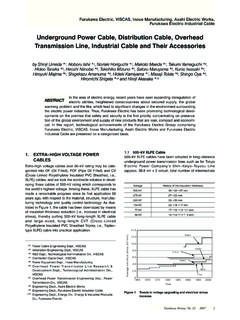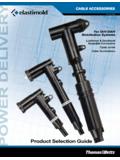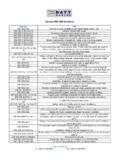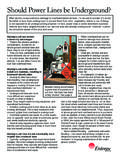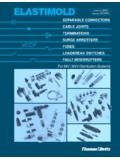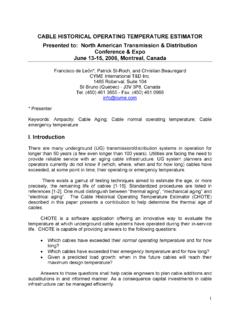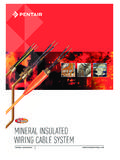Transcription of 6-36kV Medium Voltage Underground Power …
1 6-36kV Medium Voltage Underground Power CablesXLPE insulated cablesMedium Voltage Underground Cables2 cable solutions to ensure the reliability of your energy networkWith energy as the basis of its development, Nexans, the worldwide leader in the cable industry, offers an extensive range of cables and cabling systems. The Group is a global player in the infrastructure, industry, building and Local Medium Voltage Underground Cables3 Area Network markets. Nexans addresses a series of market segments from energy, transport and telecom networks to shipbuilding, oil and gas, nuclear Power , automotive, electronics, aeronautics, handling and Voltage Underground Cables4 CABLEl cable Power circuit design 7n Conductor 7-8n Conductor screen 8n Insulation 8n Insulation screen 8-9n Metallic screen 9-10n Outer protective sheath 10-11l Table of cable elements 12l cable constructions 13l cable drums 14l cable tests following production 15 ACCESSORIESl Introduction 16 l Connectors and lugs 16l Electrical fields 17l Terminations 17n Leakage path and creepage distance 17-18n Slip-on termination 18n Heat-shrinkable termination 18n Cold-shrinkable termination 18l Screened.
2 Separable connectors 18-19l Surge arresters 19l Joints 19n Transition joints 19 IIIC ontentspageMedium Voltage Underground Cables5 INSTALLATIONl cable Drum Handling 20l Installation Environment 20l Type of installation 21l Installation Temperature 22l Pulling Forces 23l Bending Radii 23l cable Support Spacing 23l Special Civil Engineering Works 24l Tests after installation 24l Current ratings 25 TECHNICAL SPECIFICATIONSl Introduction 26 l ( ) kV Three Core armoured copper conductors 27 l (12) kV Triplex / Single Core unarmoured copper conductors 28l (12) kV Triplex / Single Core unarmoured aluminium conductors 29l (12) kV Three Core unarmoured copper conductors 30l (12) kV Three Core unarmoured aluminium conductors 31l (12) kV Single Core armoured copper conductors 32l (12) kV Single Core armoured aluminium conductors 33l (12) kV Three Core armoured copper conductors 34l (12) kV Three Core armoured aluminium conductors 35l ( ) kV Single Core armoured copper conductors 36l ( ) kV Three Core armoured copper conductors 37l 12/20 (22) kV Single Core copper unarmoured conductors 38l 12/20 (22) kV Single Core armoured copper conductors 39l 12/20 (22) kV Three Core armoured copper conductors 40l 19/33 (36) kV Single Core unarmoured copper conductors 41l 19/33 (36) kV Single Core unarmoured aluminium conductors 42l 19/33 (36)
3 KV Single Core armoured copper conductors 43l 19/33 (36) kV Three Core armoured copper conductors 44 pageIIIIVAll the data given in this brochure is com-municated for information only and is not legally binding to NexansMedium Voltage Underground Cables6 General Power circuit design This brochure deals with Underground Power circuits featuring three-phase AC Voltage insulated cable with a rated Voltage between and 36kV. These lines are mainly used in a distribution network for electrical Power , connecting local substations or small generating units such as wind turbines to the main grid supply point, or for connecting plant in industrial processes which require large amounts of Power . Medium Voltage insulated cables may also be used in conjunction with bare overhead lines in Voltage of a circuit is designated in accordance with the following principles:Example: Uo/U (Um) : 19/33 (36)Phase-to-ground Voltage , designated Uo is the effective value of the Voltage between the conductor and the ground or metallic screenRated Voltage , designated U, is the effective phase to phase Voltage , designated U, is the permissible highest Voltage for which the equipment is specified.
4 In addition, the basic impulse level (BIL) determines the maximum capacity any equipment will withstand if subjected to a lightning rated Voltage of a Medium Voltage cable is determined by the thickness of the insulation. Unlike high Voltage cables which do not have set values for the insulation thickness, the thickness of the insulation around a conductor in a Medium Voltage cable is set at specified levels according to international general Voltage levels covered by this publication are:A Medium Voltage insulated cable circuit consists of three single core cables or one three core cable with terminations at each end to connect it to the transformer or switchgear in the terminations may be outdoor, mounted on a pole or indoor type in a screened the length of the circuit exceeds the capacity of a cable drum, joints are used to connect the lengths ensure the cable is fixed firmly in place under any mechanical or electrical stress, cable cleats will be used to fix it to = 19kV phase to ground voltageU = 33kV rated phase to phase Voltage Um = 36kV highest permissible Voltage of the gridUo (kV)U (kV)Um (kV)BIL (kV)Insulation Thickness (minimum average)
5 Mm* mmMedium Voltage Underground Cables7 The cableThe structure of Medium Voltage cables with extruded insulation will always involve the following items:CONDUCTOR COREFor Medium Voltage cables, conductors are rated by their effective cross sectional area in mm2 this indicates how much current can flow through the conductor the larger the conductor, the greater the amount of for Medium Voltage are normally used in the range from 35mm2 up to 1000mm2 and are usually either compacted stranded or solid some three core designs, sector shaped conductors can be used to reduce the overall diameter of the copper has a lower electrical resistance than aluminium, it is a more efficient conductor of electrical current and requires smaller cross sections to carry the same amount of Power as an aluminium conductor.
6 For example, a copper conductor of 300mm2 cross section can carry approx 670 Amps in a buried installation, yet an aluminium conductor will carry only approx 525 Amps under the same conditions. It would require a larger cross section of 500mm2 to achieve the same , aluminium is substantially lighter than copper and therefore has the advantage of enabling longer lengths to be safely handled, meaning less jointing. Also, aluminium is generally lower in price than copper on the metals commodity markets making it more economical per amp than , aluminium conductors are usually used for Medium Voltage distribution networks requiring long distances and extensive cabling, whereas copper cables are used for short links in substations and industrial installations where smaller cables or higher Power transmitting properties are conductors consist of several layers of spiral wound wires which are compacted together.
7 They are normally constructed as Class 2 according to IEC 60228 (BS EN 60228), although it is possible to use Class 5 flexible stranded conductors in conjunction with Ethylene Propylene Rubber (EPR) insulation for short stranded conductors will have spaces in the interces, there may be a requirement to longitudinally water-block the conductor by using water swellable powders or tapes in the conductor construction. These materials will block the travel of any moisture through the conductor if it was to enter at a termination or joint position. Aluminium conductors are usually water-blocked to prevent the corrosive reaction with water, but copper cables are normally not specified with these materials unless the cable is to be used in very wet conditions, subsea solid conductors, by their design are water-blocked and usually are of slightly reduced diameter than the equivalent stranded versions.
8 However, it is usually too difficult to handle these conductors for terminating and jointing for cross sections above round conductors, composed of several layers of concentric spiral-wound Voltage Underground Cables8 Around the conductor, it is necessary to provide insulation to prevent electrical short circuits. In Medium Voltage cables there are two main types of insulation material:l XLPE Cross linked Polyethylene the most common material for MV cables EPR Ethylene Propene Rubber more flexible than XLPE but not as efficient at reducing losses in circuits as XLPE. Cables used in marine and offshore applications are normally constructed with EPR :As the most common type of insulation, all data provided in this handbook is based on cables with XLPE to the requirements of various standards, cables for Medium and high voltages require three specific layers of extruded material around the conductor to form the insulation layers are known as the conductor screen, insulation and insulation screen and are normally extruded in one operation, known as triple pass, or triple SCREEN ON THE CONDUCTOR (KNOWN AS THE CONDUCTOR SCREEN )
9 This consists of a layer of black semi-conductive cross linked compound, usually less than in thickness, which is the interface between the conductor and the external surfaces of the conductor may not be smooth, particularly for stranded conductors, so this layer provides a smooth surface at the same potential as the conductor to keep the electric field consistent all the way around the surface. Without this layer, any small peaks or troughs could cause concentrations of electrical energy which could create small arcs, and over time could erode the insulation layer and cause failure of the cable . The conductor screen is fully bonded to the adjacent insulation its name suggests, the insulation insulates the conductor at Voltage from the outer screens which are at ground potential.
10 The insulation must be of sufficient thickness to withstand the electric field under the rated and transient operating conditions see the table on insulation thickness in previous to the cross linking structure of XLPE, it enables the cables to run safely at higher temperatures than thermoplastic materials such as PVC, and therefore carry more current. The continuous current ratings found in this document are based on conductor temperatures of 90 C which is the accepted maximum normal working temperature for cables in a short circuit, the XLPE can accommodate conductor temperatures of up to 250 three core Medium Voltage cables, the insulation is left in its natural colour and is not used for core identification this is achieved by either printing on the insulation screen or colour coded tubes between the cores or marker SCREEN ON INSULATION (KNOWN AS THE INSULATION SCREEN )This layer has a similar function to the conductor screen.

